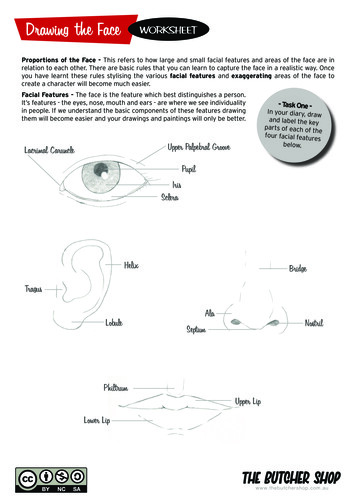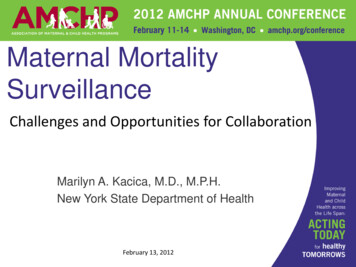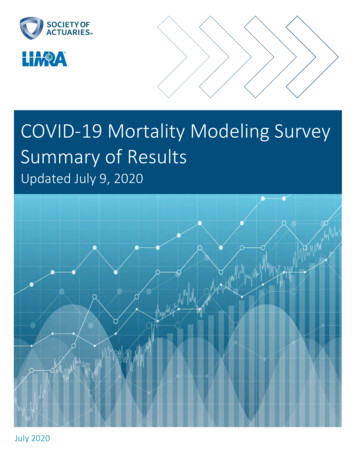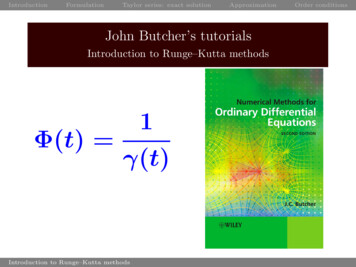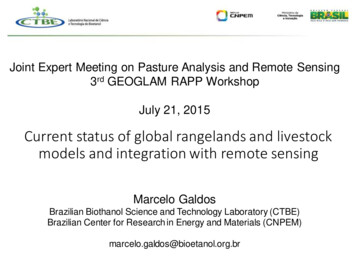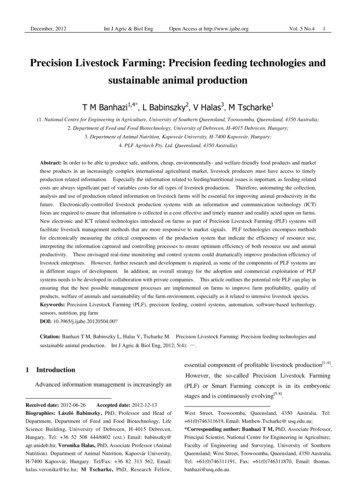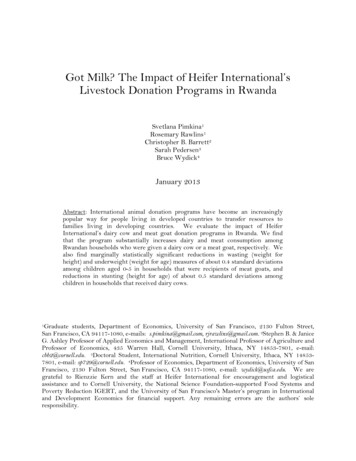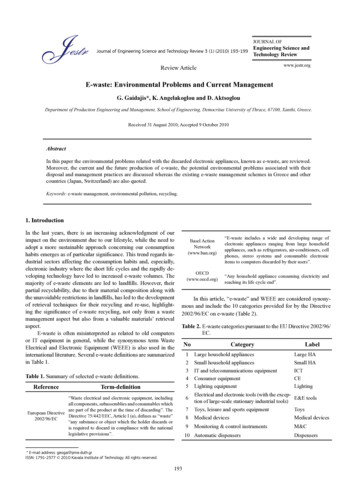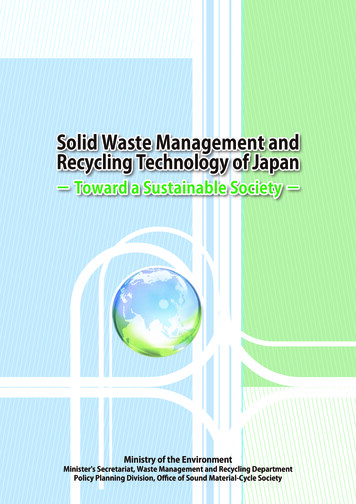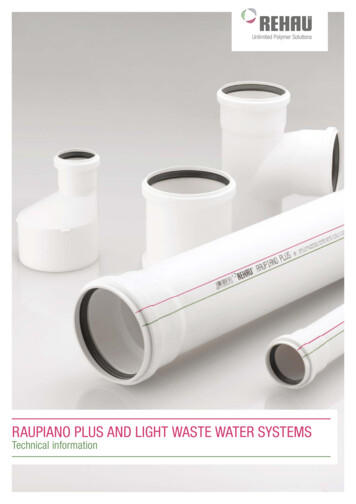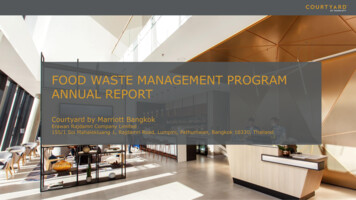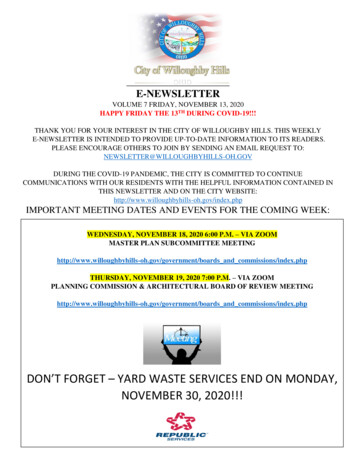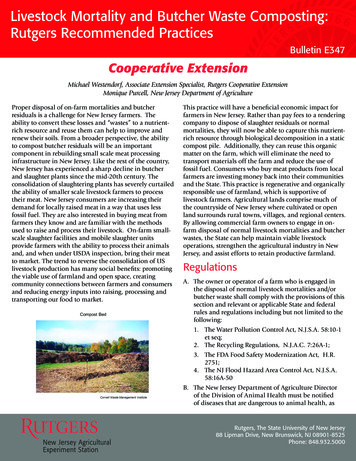
Transcription
Livestock Mortality and Butcher Waste Composting:Rutgers Recommended PracticesBulletin E347Cooperative ExtensionMichael Westendorf, Associate Extension Specialist, Rutgers Cooperative ExtensionMonique Purcell, New Jersey Department of AgricultureProper disposal of on-farm mortalities and butcherresiduals is a challenge for New Jersey farmers. Theability to convert these losses and “wastes” to a nutrientrich resource and reuse them can help to improve andrenew their soils. From a broader perspective, the abilityto compost butcher residuals will be an importantcomponent in rebuilding small scale meat processinginfrastructure in New Jersey. Like the rest of the country,New Jersey has experienced a sharp decline in butcherand slaughter plants since the mid-20th century. Theconsolidation of slaughtering plants has severely curtailedthe ability of smaller scale livestock farmers to processtheir meat. New Jersey consumers are increasing theirdemand for locally raised meat in a way that uses lessfossil fuel. They are also interested in buying meat fromfarmers they know and are familiar with the methodsused to raise and process their livestock. On-farm smallscale slaughter facilities and mobile slaughter unitsprovide farmers with the ability to process their animalsand, and when under USDA inspection, bring their meatto market. The trend to reverse the consolidation of USlivestock production has many social benefits: promotingthe viable use of farmland and open space, creatingcommunity connections between farmers and consumersand reducing energy inputs into raising, processing andtransporting our food to market.This practice will have a beneficial economic impact forfarmers in New Jersey. Rather than pay fees to a renderingcompany to dispose of slaughter residuals or normalmortalities, they will now be able to capture this nutrientrich resource through biological decomposition in a staticcompost pile. Additionally, they can reuse this organicmatter on the farm, which will eliminate the need totransport materials off the farm and reduce the use offossil fuel. Consumers who buy meat products from localfarmers are investing money back into their communitiesand the State. This practice is regenerative and organicallyresponsible use of farmland, which is supportive oflivestock farmers. Agricultural lands comprise much ofthe countryside of New Jersey where cultivated or openland surrounds rural towns, villages, and regional centers.By allowing commercial farm owners to engage in onfarm disposal of normal livestock mortalities and butcherwastes, the State can help maintain viable livestockoperations, strengthen the agricultural industry in NewJersey, and assist efforts to retain productive farmland.RegulationsA. The owner or operator of a farm who is engaged inthe disposal of normal livestock mortalities and/orbutcher waste shall comply with the provisions of thissection and relevant or applicable State and federalrules and regulations including but not limited to thefollowing:1. The Water Pollution Control Act, N.J.S.A. 58:10-1et seq;2. The Recycling Regulations, N.J.A.C. 7:26A-1;3. The FDA Food Safety Modernization Act, H.R.2751;4. The NJ Flood Hazard Area Control Act, N.J.S.A.58:16A-50B. The New Jersey Department of Agriculture Directorof the Division of Animal Health must be notifiedof diseases that are dangerous to animal health, asRutgers, The State University of New Jersey88 Lipman Drive, New Brunswick, NJ 08901-8525Phone: 848.932.5000
enumerated in N.J.A.C. 2:2-1.1. The Director will thenprovide an acceptable means of disposal.C. Routine burial as outlined in this document only applies where sporadic, individual mortalities occur.D. In situations involving catastrophic mortality losses,such as whole herd or flock disposal due to diseaseor catastrophic events, contact the New JerseyDepartment of Agriculture Division of AnimalHealth at 609-671-6400 immediately for additionalinformation and instructions.E. Animals exhibiting signs of neurological diseasebefore death should be reported to the New JerseyDepartment of Agriculture Division of Animal Healthat 609-671-6400 for autopsy and proper disposal.F. Records on normal mortality burial(s) and compostingactivities must be maintained.G. Composted mortality and butcher waste must alsohave been generated on-site, pursuant to N.J.A.C.7:26A-1.4(a)2. Carbon sources may be brought on site,pursuant to N.J.A.C. 7:26A-1.4(a)3.H. Written notice of the operation must be made to theNew Jersey Department of Environmental Protection,Division of Solid & Hazardous Waste, Bureau ofRecycling & Planning, P.O. Box 414, Trenton, NJ08625-0414, the host municipality and the hostcounty, prior to the start of operations. Specificsregarding the written notice of an exempt operationthat includes a certification is found at N.J.A.C.7:26A-1.4(b)5.Definitions“Batch” means the amount of butcher waste beingcomposted in a given time period.“Bins” means an open structure designed to containcompost and withstand the force of equipment used forcompost movement. A typical bin is 6-12 feet wide and5-8 feet deep.“Burial” means a process by which carcasses are disposedof by excavating a pit or trench, placing the carcass in it,and covering it over.“Butcher Waste” means animal tissues, organs or bodilyfluids which are by-products from livestock slaughter.They are also referred to as residuals.“Composting” means the biological decomposition andstabilization of organic matter exposed to air and creatingconditions of high temperature (104 – 140 F), resulting ina humus-like product.“Container” means any portable device in whichmaterials are stored, transported, treated, disposed of, orotherwise handled.“Domestic Livestock” means cattle, horses, donkeys,swine, sheep, goats, rabbits, poultry, fowl and anyother domesticated animal deemed by the State Boardof Agriculture and the Department of Agriculture, inconsultation with the New Jersey Agricultural ExperimentStation.“Floodway” means land, and the space above that land,which lies within the inner portion of the flood hazardarea, and which is mathematically determined to berequired to carry and discharge floodwaters resultingfrom the 100-year flood under certain conditions. Thefloodway always includes the channel and often includesland adjacent to the channel. The floodway is normallycharacterized by faster and deeper flows than the floodfringe, which is the portion of the flood hazard areaoutside the floodway.“Large Animal” means animals which weigh more than100 pounds.“Leachate” means a liquid that has been in contactwith or percolated through a porous solid and extracteddissolved and suspended material.“Mesophilic Stage” means a stage of composting thatbegins when the materials are first heaped together ina windrow, static pile or bin. The temperature of thecore begins to rise and microorganisms start to formcolonies and multiply within the pile. During this stagetemperatures reach 77 to 104 F.“Normal Mortality” means a mortality which occursroutinely and is not the result of disease epidemic,inoculation, experimental treatment or farming disastersuch as fire or suffocation.“Owner” means the owner of record of the commercial farm.“Small Animal” means animals which weigh 100 poundsor less.“Static Piles” means piles of composting material that arenot turned during the composting process. A typical staticpile is sized the same as windrows, 8-12 feet wide by 6-8feet high with a length as long as the batch requires.
Best Management PracticesBurial of Normal Mortalities1. Farmers may bury their own domestic livestock ontheir own property not qualifying as wetlands or afloodway, as long as the burial does not cause odors,is at a sufficient depth to prevent wildlife or otheranimals from excavating the remains and is allowedper all other requirements such as local ordinances.2. Call before you dig to ensure underground lines frommunicipal utilities are not damaged , 1-800-272-1000.“Thermophilic Stage” means a stage of composting whenthe compost heats up reaching 140 . Harmful bacteriadie off and the pile starts to breakdown rapidly. Thecompost pile should be damp and sufficient air shouldreach the core of the pile. This stage can last up to 3months depending on materials and the type of methodemployed.“USDA inspected premises” means the area where allactivities are subject to the rules and regulations of theUnited States Department of Agriculture for FederalMeat Poultry or Import Inspection. This includes aslaughter facility, a mobile slaughter unit and the groundsimmediately surrounding these facilities as well as theantemortum animal holding pens.“Waters of the State” means all surface and groundwaters in New Jersey but does not include closed systemaquatic farms.“Wetland” means an area that is inundated or saturatedby surface water or groundwater at a frequency andduration sufficient to support, and that under normalcircumstances does support, a prevalence of vegetationtypically adapted for life in saturated soil conditions,commonly known as hydrophytic vegetation; provided,however, that the Department of EnvironmentalProtection, in designating a wetland, shall use thethree-parameter approach (that is, hydrology, soils andvegetation) enumerated in the 1989 Federal Manual asdefined in this section. These include tidally influencedwetlands which have not been included on a promulgatedmap pursuant to the Wetlands Act of 1970, N.J.S.A. 13:9A1 et seq.“Windrow” means a constructed elongated pile or rowof composting material that can vary in size and spacing.A typical windrow is 8-12 feet wide by 6-8 feet high.Space between windrows can vary between inches andfeet depending on spacing. When composting livestockmortalities or butcher waste the windrows are not turnedor restacked until tissues are digested.a. Burial sites must be:i. Located outside of the floodwayii. A minimum of 100 feet from waters of thestateiii. Covered with a minimum of 2 feet of soilwithin 48 hoursb. Burial sites should be:i. Located a minimum of 100 feet from wellsand sinkholesii. At least 100 feet from property linesiii. Away from public viewc. The bottom of burial sites should be:i. At least 2 feet above bedrockii. At least 2 feet above the seasonal highwater tableiii. At least 2 feet above highly permeable soils.d. Identify sites on GIS maps or seek technicalassistance from your local Soil ConservationDistrict or USDA NRCS office to help determinethe best burial site(s) on the farm.e. Burial sites shall be inspected by the farmerperiodically to assure that the site is secure.f. Re-vegetate the area once the burial site is closed.Composting of Normal Mortalities1. On-site composting will employ one of three methods:a. Windrowsb. Static Pilesc. Bins2. Compost windrows, static piles or bins shall be constructed, maintained and sheltered such that compost
materials cannot be dispersed by wind and rain, andcombustion and fire are prevented.3. The following materials shall not be used incomposting:a. Hazardous wasteb. Treated or painted woodc. Municipal wastewater treatment sludge, biosolidsor septic waste4. Compost windrows, static piles or bins shall be:a. At least 50 feet from property lines.b. A minimum of 100 feet from waters of the state.c. Located outside of the floodway.d. 200 feet from any well or spring currently usedas a drinking water source.e. 50 feet from caves and sinkholes.f Two feet above the seasonal high water tableunless on an impervious surface such as concreteor asphalt.g. 50 feet from rock outcrops.h. 50 feet from intermittently flowing drainageswales or ditches.i. In an area with minimal slope to prevent runoff(1–2% slope recommended).j. At least 200 feet from adjacent residences.5. Carbon Sourcesa. Wood chipsb. Refused feedc. Spoiled silaged. Chopped cornstalke. Nut hullsf. Straw/hayg. Brewery wasteh. Leavesi. Shavings and sawdustNote: With the exception of wood chips, thismaterial should not be used for the compost bed,but can be used to insulate and filter odor in theouter layers of the windrow or static pile.Composting Recipe for Small Animals1. Create a compost bed with 2 feet of carbonmaterial (preferably wet – it can be bowl-shaped)using a chunky carbon source (woodchips areideal) to allow air flow aroundthe carcass.2. Layer mortalities and cover with a minimum of2 feet of carbon material above each layer to amaximum of 7 feet.3. In dry weather, add water during pile constructionand shape piles for moisture control.4. Make sure that all animals are well covered tominimize odor, generate heat and to keepunwanted animals and insects out of the pile.5. If leachate is visible, additional carbon materialmust be added.6. Provide clear signage in the composting area.7. Let sit for 4–6 months.8. The pile must be insulated (covered with a layerof bulking material or finished compost)and atemperature of not less than 131ºF (55ºC) mustbe maintained throughout the pile for atleast3 consecutive days – monitored at 6–8inches from the top of the pile.9. Bones can be used to provide structure to thenext pile.Composting Recipe for Large Animals1. Create a compost bed with two feet of carbonmaterial (preferably wet – it can be bowl-shaped) using a chunky carbon source (woodchipsare ideal) to allow air flow aroundthecarcass.
2. Ensure the compost bed is large enough to allowfor 2 foot clearance around the carcass.3. In dry weather, add water during pile constructionand shape piles for moisture control.4. Lay the animal in the center of the bed.5. Lance the rumen, stomach or intestines to avoidbloating and possible explosion.6. Cover carcass and the entire bed with a minimumof 2 feet of chunky carbon material.7. Make sure that all residuals are well covered tominimize odor, generate heat and to keepunwanted animals out of the pile.8. If leachate is visible, additional carbon materialmust be added.9. Provide clear signage in the composting area.10. Let sit for 4–6 months.11. The pile must be insulated (covered with a layerof bulking material or finished compost) and atemperature of not less than 131ºF (55ºC) mustbe maintained throughout the pile for at least3 consecutive days, when monitored 6–8 inchesfrom the top of pile.12. Bones can be used to provide structure to thenext pile.Butcher Waste Composting1. All process wastewater generated (wastewater from theslaughter or butchering process) during the harvesting process must be collected and stored on site in adurable container with a tight-fitting lid. The processwastewater shall not be land applied. The processwastewater may be utilized during the composting ofbutcher waste as outlined below.2. Space Requirementsa. There are two calculators available for determininghow much space is needed to compost butcherwaste:1. Co-Composter Model is a Microsoft excelspreadsheet developed by Cornell Universitythat provides mass and volume balances, areaestimations for storage, active compostingand curing and a cost analysis of alternatecomposting systems based on inputs enteredby the user. It can be found at compost.css.cornell.edu/CoCompost.html. Whencalculating butcher residuals start withquestion #8 on the user input page.2. Spartan Animal Tissue Composting (ATC)System Planner is aMicrosoft excel applicationdeveloped at Michigan State University thatassists in designing a composting system usinga static approach and gives the option of usingeither bins, windrows or static piles. Themodel calculates the amount of space neededfor composting only. It does not take intoaccount the curing or storage of raw materials.It can be found at msu.edu/ rozeboom/catrn.html.b. To use either of these calculators, the followinginformation is needed:1. The weight and/or volume of by-products generated.a. Table 1 below shows the typical yield ofretails cuts and by-products from cows,pigs and lambs. These percentages can beused or an average of actual weights orvolumes from your operation can be used.b. Total Pounds to be Composted Liveweight – Retail cuts – Hide – Edible fats –Variety meats – ½ Bones – 3% Other2. The amount of carbon needed to be able tocompost properly.3. Animal tissue density: successful animal tissuecomposting is accomplished by using 1 ft³ ofbulking material for every ½ to 15 lbs of tissue.However, if density is greater than 10 lbs/ft³then the addition of 1 ft³ of bulking materialfor every 4 to 6 lbs. of tissue will work best.4. The type of composting system you plan to use.a. Windrow, static piles or bins and theapproximate dimensions of the system.
5. The length of time during which compostingwill occur.a. Typically this will take between 2–6months occurring in 3 stages: Mesophilic Stage Thermophilic Stage Mesophilic Stageb. The mesophilic stage starts when thematerials are first heaped together. Thetemperature of the core begins to rise andmicroorganisms start to form colonies.This stage lasts 2–5 days.c. During the thermophilic stagetemperatures of 104ºF to 140ºF (40ºC to60ºC) must be reached and maintainedfor thorough decomposition and pathogenkill. The time needed to maintain thetemperature depends upon the amount/weight of the residuals being composted.Compost will “sag” or settle.d. After this active, hot phase the compostmust go through another mesophilic stagewith temperatures of 77ºF to 104ºF (25º to40ºC) to finish the composting process.e. Bone degradation takes longer. It maytake several compost cycles dependingon compost management and duration.However, piles with bones can be used toprovide structure to the next pile.c. Additional Information compost.css.cornell.edu/CoCompost.html needed for Co-ComposterModel:1. Density of flesh waste.2. Moisture content of flesh waste.3. Nitrogen content of flesh waste.4. Carbon to Nitrogen ratio (C:N) of flesh waste.d. Additional information msu.edu/ rozeboom/catrn.html needed for Spartan ATC SystemPlanner:1. An estimate of the number of months that willbe required to start and complete the creationof a new batch.2. The length, width and height of the windrows,static piles or bins.8. Space Required for Primary Compostinga. A comparison of the pad size, including theworking space needed for composting the butcherwaste from processing one cow, one pig and onelamb is shown in Table 2.b. The total amount of space required for the entirecomposting process including the storage ofraw materials, composting and curing is onlyestimated in the Co-Composter Model.c. Typically the total amount of space for the entirecomposting process is 1.5 to 2.5 times the areasrequired just for composting.More information can be found at the Cornell WasteManagement Institute, Department of Crop & SoilSciences, cwmi.css.cornell.edu.ReferencesComposting Animal Mortalities. 2009. Morse D. E.Agricultural Development and Financial AssistanceDivision. Minnesota Department of Agriculture. St. Paul,MN. mda.state.mn.us.Composting Facility Standard (No.) Code 317. NaturalResources Conservation Service.Livestock & Poultry Mortality Disposal in PA. PAAgricultural Ombudsman Program.Natural Rendering: Composting Livestock Mortality andButcher Waste. Cornell University, Ithaca, On-Site Composting of Routine Animal Mortality – Guidance Memo # 02-2009. Commonwealth of Virginia, Department of Environmental Quality.Rules & Regulations Relating to Disease Control ofDomestic Animals and Poultry. Chapter 211. MaineDepartment of Agriculture.The Space it Takes: Footprint Calculator for CompostingButcher Waste. Cornell University, Ithaca, NY.cwmi.css.cornell.edu/spaceittakes.pdf
Table 1. Typical yield of retails cuts and by-products from cows, pigs, and lambsCowLive Weight (wt)Retail CutsBy-productsHideEdible fatsVariety meatsBloodInedible fats & meatscrapsBonesOther (stomachcontents, shrink, etc.)Piglb.1000420% of live 0lb.220123Lamb% of live weight% of live 8.92.24.4178.02222.22612.011.111.135.6Table 2. Size requirements for composting padsTarget Density (lbs/ft³)Co-Composter (ft²)Spartan ATC (ft²)Cow413.418.9511.315.169.613 2015 Rutgers, The State University of New Jersey. All rights reserved.Pig41.72.351.61.961.51.9Lamb41.31.6For a comprehensive list of our publications visit www.njaes.rutgers.eduCooperating Agencies: 51.01.461.01.3February 2015Rutgers, The State University of New Jersey, U.S. Department of Agriculture, and County Boards of Chosen Freeholders. Rutgers Cooperative Extension, a unit of theRutgers New Jersey Agricultural Experiment Station, is an equal opportunity program provider and employer.Rutgers, The State University of New Jersey88 Lipman Drive, New Brunswick, NJ 08901-8525Phone: 848.932.5000
Rather than pay fees to a rendering company to dispose of slaughter residuals or normal mortalities, they will now be able to capture this nutrient-rich resource through biological decomposition in a static compost pile. Additionally, they can reuse this org
